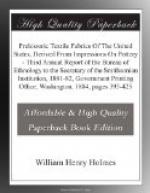We have also good examples from Saline River, Illinois. They are obtained from fragments of the gigantic salt vessels so plentiful in that locality.
The upper figure of Plate XXXIX illustrates one of these specimens. Other examples hare been obtained from Roane County, Tennessee.
A piece of charred cloth from a mound in Butler County, Ohio, has been woven in this manner. Foster has described examples of the two preceding forms from the same locality. The material used is a vegetable fiber obtained from the bark of trees or from some fibrous weed. This specimen is now in the National Museum.
An interesting variety of this form is given in Fig. 96. It is from a small piece of pottery exhumed from a mound on Fain’s Island, Jefferson County, Tennessee. The threads of the woof are quite close together, those of the web far apart.
[Illustration: Fig. 96.—From ancient pottery, Tennessee.]
A very fine example of this variety of fabric was
obtained by Dr. Tarrow
from an ancient cemetery near Dos Pueblos, Cal.
It is illustrated in
Fig. 2, Plate XIV, vol. VII, of Surveys West
of the 100th Meridian.[4]
In describing it, Professor Putnam says that the fiber
is probably
obtained from a species of yucca. He says
that
“the woof is made of two strands,
crossing the warp in such a manner
that the strands alternate in passing,
over and under it, and at the
same time inclosing two alternate strands,
of the latter, making a
letter X figure of the warp, united at
the center of the X by the
double strands of the woof.”
It should be noticed that the series of cords called
the woof by
Professor Putnam are designated as warp in my own
descriptions. The
illustration shows a fabric identical with that given
in the upper
figure of Plate XXXIX, and the description quoted
describes perfectly
the type of fabric under consideration.
[Footnote 4: Putnam,
F. W., in Vol. VII of Surveys West of the
100th Meridian, page 244.]
This method of weaving is still practiced by some of the western tribes, as may be seen by a visit to the national collection.
A somewhat complicated arrangement of the threads may be seen in the fabric shown in Fig. 97. It is clearly only a variation of the combination just described. The manner in which the threads pass over, under, and across each other can be more easily understood by reference to the figure than by any description. It comes from one of the Northwest coast tribes.
[Illustration: Fig. 97.—Modern fabric, Northwest coast.]
Fourth group.
A fourth form of fabric, illustrated in Fig. 98, is of very rare occurrence on our fictile remains.
[Illustration: Fig. 98.—Diagonal
fabric, ancient pottery of
Tennessee.]
It is a very neatly woven diagonal from the ancient pottery of Polk County, Tennessee. Two series of cords have been interwoven at right angles to each other, but so arranged as to produce a diagonal pattern. One series of the cords is fine and well twisted, the other coarser and very slightly twisted.




